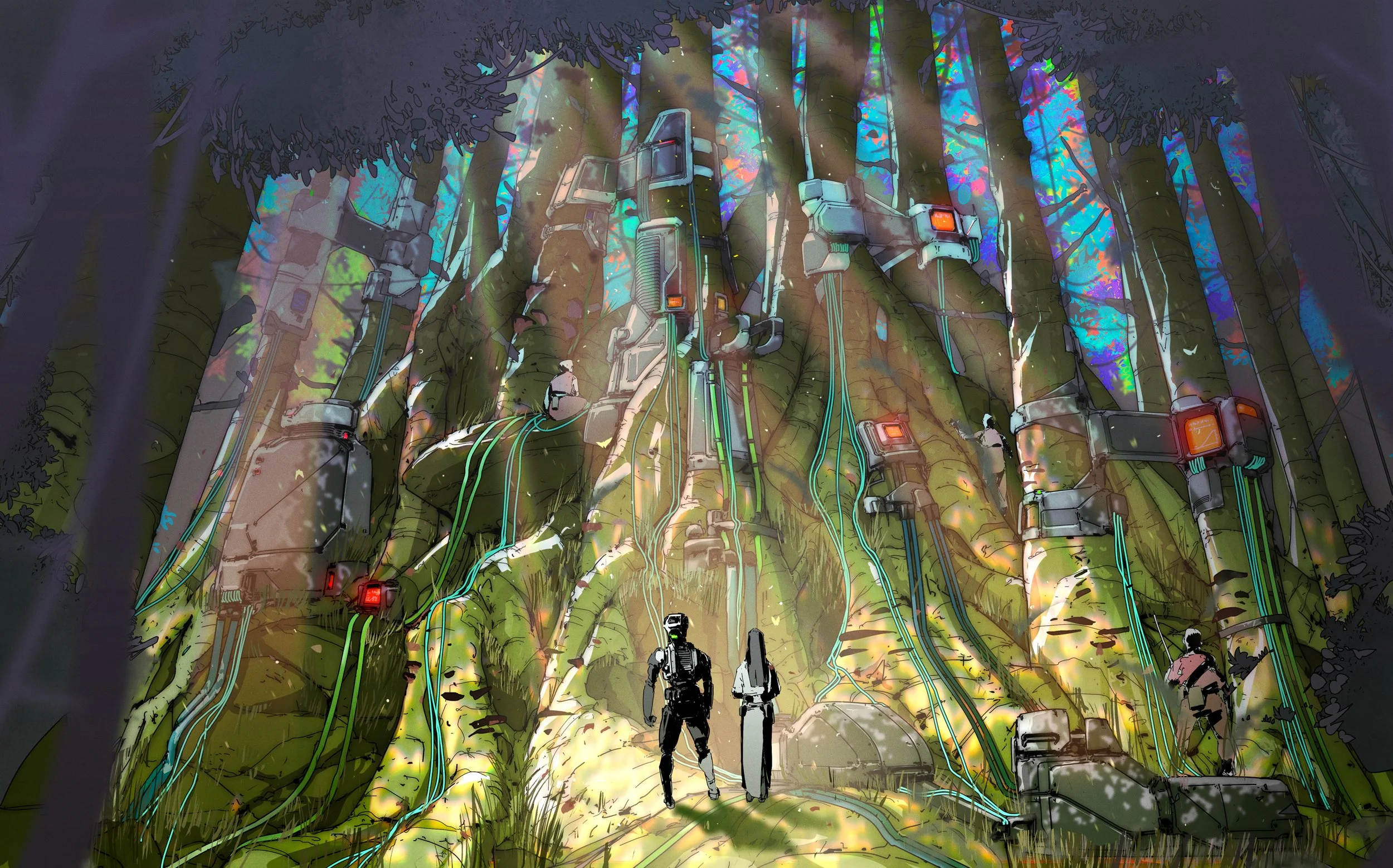a place in need
By 2130, the relentless forces of globalization, deforestation, and climate change had displaced countless species from their native habitats, pushing them into remote sanctuaries beyond the reach of human exploitation. One such sanctuary was the Forest of the Spirit’s Hand. Having been largely untouched by the march of industrialization and technological progress, the forest had long been a subject of study for ecologists, botanists, zoologists, and other researchers. Over decades, they witnessed firsthand how its delicate communities continuously adapted in response to the rapidly shifting biological landscape.
However, the acceleration of change began to be too much for some of the forest’s native tree species. Prolonged droughts weakened their root systems, inhibiting their ability to absorb groundwater during the increasingly rare monsoon seasons; As their branches grew brittle and their trunks hollowed out, they became vulnerable to infestation, disease, and decay. Their lifespans shortened, and their numbers began to dwindle. The decline of these trees posed a grave threat to the health of the entire forest, endangering its intricate web of life.
As the forest’s future grew uncertain, local governments and industries, seizing on its weakening state, began eyeing its natural resources. Although deforestation had previously been hindered by logistical challenges and the high cost of access, they reasoned that if the forest was doomed to decline, it might as well be exploited before it vanished entirely.
setting up camp
With this added pressure, the preservation of Spirit’s Hand became a focal point of discussion and protest by local communities and activist organizations around the world. With industrial expansion unabating and unchecked, it seemed there would soon be no sanctuary left untouched. In the wake of this crisis, many of the researchers and scientists who dedicated their lives to studying and preserving the forest knew they had to act. Despite resistance from more conservative government authorities, they were granted permission to establish a settlement at the edge of the forest. With the backing of governmental bodies, numerous science organizations, preservation societies, and nearby local communities, humans and robots worked side by side to build what would become known as the village of Rebourne—a beacon of hope for the forest’s survival.
Being a purpose-built community, Rebourne amassed a population of close to 1500 people spanning countless vocations after just a few years. Small business entrepreneurs, public safety and healthcare officials, utility workers, educators—the eagerness of so many people to get a fresh start and support this endeavor was truly miraculous. And at the heart of it all were the people the village was built for: the Rebourne Preservation Initiative—a coalition of all those dedicated scientists, engineers, researchers coming together to solve this crisis.
Phase 1: Project Hydrostasis
It wasn’t long before a groundbreaking idea took root amongst the members of RPI: the integration of robotics and machinery into the very life of the forest. A completely novel field of science, it drew on a wide range of expertise and resources. With the guidance of botanists and ecologists, mechanical and robotics engineers began outfitting many elder trees—those most at risk of dying—with artificial life-support systems designed to keep water flowing through their bodies and roots. They called this endeavor Project Hydrostasis.
Integrating robotics into living trees was no simple task. Machinery was implemented piece by piece to avoid shocking the trees, and the process became one of trial and error. Some attempts faltered, but each failure offered valuable insights that refined the technology. They constructed intricate networks of pipes, connecting the village’s water supply to the forest and diverting extra water directly to the bodies and roots of the elder trees. Storage and siphoning systems were embedded within the trees themselves, carefully regulating water flow to avoid oversaturation, accounting for the changing seasons and erratic weather patterns.
It was just the beginning—a fragile first step in what could be a new chapter for this place. But with each passing day, the hope of giving the forest—and its inhabitants—a second chance at life grew stronger.
In 2138, an unusually harsh dry season left the forest more brittle and exposed than expected, and when a sudden wildfire struck, it swept through the land with devastating force. Though the flames were stopped before they could reach the village itself, the damage was deeply felt. Many of the trees that RPI had worked so carefully to preserve were reduced to ash in a matter of hours. The loss was more than ecological; it was personal, felt in the hearts of everyone in Rebourne who had lived in quiet partnership with the forest.
Still, hope endured. With much of the woodland still standing, construction began to reinforce the most vulnerable edges of the forest with new fire-resistant barriers and emergency water lines—a reassurance that their work would continue regardless of setbacks.
And so, just two years later in 2140 the Rebourne Preservation Initiative had successfully integrated artificial life-support robotics into nearly 90% of the elder trees at risk of dying, officially mitigating an unstable ecological collapse. It was a groundbreaking achievement—hailed as a revolutionary leap in the preservation of endangered plant species worldwide. In celebration of their accomplishments, Spirit’s Hand colloquially became known as the Rebourne Forest. Inspired by Rebourne’s research, scientists across the globe began developing and adapting their own robotic life-support systems, tailored to the unique needs of their local ecosystems.
Phase 2: Operation Helping Hand
While the technological advancements and efforts of Project Hydrostasis had preserved the elder trees, it was ultimately a temporary solution. The young of these species, though not yet at risk, faced an uncertain future in a rapidly shifting climate and ecosystem. In all likelihood, they would encounter these threats even earlier in their lifespans than their predecessors. Sooner or later, mechanical integration would become a necessity for them all.
Rebourne believed that intervention was needed sooner in a tree’s life. This marked the beginning of the second phase of their work: Operation Helping Hand. The team envisioned integrating robotics and artificial intelligence into seedlings—a step that would offer support from the onset of growth, as well as simplify future enhancements and maintenance. They believed this would give the trees a true chance at survival and pave the way for the sustainability of sanctuary ecosystems like Rebourne Forest all over the world.








